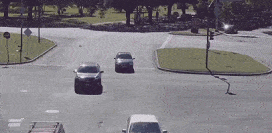|
What do you guys mean? That urban sprawl is markedly different in the metropolitan areas of Atlanta, Dallas, or Tampa as compared to Melbourne, which AFAIK has had much of the same problems? Land use economics don't exactly stop at municipal borders, especially when there's no strong culture of planning or much legislative force to halt base market incentives. South Africa has a way different government setup than either the US or Oz, but as a country it has produced the same kinds of cities, with the added 'features' of horrendous racial segregation and city center blight of course. And all I ever hear about urban planning in New Zealand is how they hosed it up as well. On a macro scale, what does it matter that people live in Onehunga, Germiston, Marietta, or Essendon, and there might or might not be an invisible border between them - different county, municipality, council, unincorporated, whatever - and the place miles away where they built a few tall buildings? Either it's all the same local level government and they're deep in someone else's pocket, or you have competing jurisdictions in a never-ending race to the bottom. Then, as far as traffic goes, in most of these places there is a higher level of government involved that had been spending a lot of money on freeways but now faces liquidity problems, plus essential PT getting shortchanged by fragmented or weak local jurisdictions. e: VVV oh yeah, sure Koesj fucked around with this message at 02:14 on Feb 5, 2015 |
|
|
|

|
| # ? May 10, 2024 12:15 |
|
Koesj posted:What do you guys mean? That urban sprawl is markedly different in the metropolitan areas of Atlanta, Dallas, or Tampa as compared to Melbourne, which AFAIK has had much of the same problems? That Australia has nothing but Atlantas and Dallases.
|
|
|
Lead out in cuffs posted:The other reason why cyclists shouldn't use sidewalks (besides not being an rear end in a top hat endangering pedestrians) This logic irritates me. Instead of a 220 lb combined me + bike "endangering" pedestrians, I have to ride in the roadway and be actually endangered by two ton cars (or their doors) who give less of a gently caress about me than they do a road cone. The overwhelming attitude from non-cyclists is "you must be crazy to ride in the road!". I'd love it if it were a choice, cause I agree, dudes. Give me a viable bike lane that isn't 18 inches between the curb and a traffic lane and I'll change my tune, though. E: gently caress, last page
|
|
|
|
|
poo poo, I actually made some graphics a couple of weeks ago for yucks (well, for some ongoing mucking around) On these, north is top-right, the grids are 10km. 2011 ABS Census. I've tried to make the representative volumes as close to 1:1 actual population possible.  Sydney, plus Wollongong on the left, Gosford peeking in on the right)  Melbourne. Geelong is on the smaller bay on the left, Ballarat doesn't quite make it into this picture.  Brisbane in the middle, Gold Coast stretches towards the bottom.  Perth, which is possibly the worst offender as far as unremitting sprawl with few proper high rise areas goes. I've done most of the larger cities/regions as an album, for laughable quantities of "large", since we only have five urban centres larger than a million. http://imgur.com/a/PPRon The Deadly Hume fucked around with this message at 05:32 on Feb 5, 2015 |
|
|
|
Nintendo Kid posted:6 mph is their top speed typically, and people rarely go flat out on them. Check out the manufacturers and retailers themselves: There are plenty of outdoor scooters that push 10 mph for the people that want them. And the reality is that the current laws go far beyond those scooters, and include everything from Segways to golf carts to gas-powered mopeds. Also your assertion that people "walk" at 5 or 6 mph is patently absurd. That's something like an 11 min mile. A quick walking pace is going to be more like a 15-18 minute mile depending on age and health. And that is still going to be faster than the average unhurried walking pace, which is slightly over 3 mph (20 minute mile). http://www.1800wheelchair.com/category/outdoor-mobility-scooters/ http://www.1800wheelchair.com/category/heavy-duty-mobility-scooters/ I really think that your perspective may be a bit out of date when it comes to the advent of mobility scooters and their popularity. People were complaining about overuse of scooters in public areas, and of healthy people using scooters for mere convenience, more than a decade ago - and the issue has not disappeared: http://www.post-gazette.com/life/lifestyle/2006/07/17/Make-way-for-the-sidewalk-SUV-Mobility-scooters/stories/200607170104 http://www.13abc.com/story/25908412/archbold-police-ticket-disabled-man-for-driving-scooter-on-sidewalk At this point there's all sorts of folks getting invested in the issue, from disability advocates and scooter manufacturers to nature conservancies worried their trail systems and hotel industry lobbyists balking at the idea of people driving Segways and golf carts down their halls: http://www.americanmobilityscooters...e-highways.html http://www.americantrails.org/resources/accessible/powermobilityquestions.html http://hotelexecutive.com/business_review/2711/ada-compliance-wheelchairs-and-other-power-driven-mobility-devices It definitely shouldn't be dismissed as a non-issue involving just a couple of old ladies with souped up wheelchairs. At the very least, it's very big business for manufacturers who have had significant success in getting the devices covered under Medicaid and other medical insurance programs, and have a vested interest in promoting their widespread adoption. Many of these devices are very helpful for people, but they're also very capable of causing disruption to pedestrian spaces and that needs to be addressed and resolved. Right now it's happening at a city-by-city level, and generally in a way that is very difficult for people that rely on these scooters to get around. American tourism forums are filled with discussions about the specific municipal regulations for mobility scooters, and people asking about whether or not they're going to be able to use the devices freely since there is a lack of standardized regulation. Similarly, there's many complaints in other forums about people who are abusing these devices and causing issues for other users of pedestrian-ways. And at the same time, some of these device advocates are pressing for greater acceptance of these devices in our common spaces, regardless of disability, even going so far as suggesting that gas-powered ATVs should be considered "personal mobility devices". So yeah, there needs to be a discussion. And most likely it needs to start by talking about limiting their speeds and capabilities, and encouraging people who want to go faster to use other devices and other spaces. A 500-lb device that can travel 15 mph (http://www.1800wheelchair.com/product/ew-37/) should not be under the same regulations as a wheelchair. Kaal fucked around with this message at 18:21 on Feb 5, 2015 |
|
|
|
Javid posted:
Well, yes, of course. But you're still at more risk riding on the sidewalk than you are on the road, even with the occasional psychopathic American driver. Vehicular cycling is a stupid but necessary hack around a broken system.
|
|
|
|
Lobsterpillar posted:Whats the professional etiquette for you guys posting details about what you're currently working on in this thread? Is it okay because they're public works that don't require any sort of confidentiality, and the information is publicly available anyway? Everything I've been talking about is technically public record, and I'm careful to avoid anything that might be controversial. Nothing I wouldn't tell someone at a public info meeting if they asked. It is a tricky situation, though, because there's a lot I'd LIKE to tell you guys but don't out of prudence.
|
|
|
|
The Deadly Hume posted:
All of these images are fantastic but as a resident of Perth I find this one the most fascinating. Do you have plans to create any more? I think it would be interesting to compare the sprawl prior to 2007, before the Mandurah line opened. The progression of this sprawl will only continue in the future as the new lines are created and existing ones expanded. I personally don't see this as an issue as public transport in Perth is already widely accepted as an extremely valuable part of the overall transportation infrastructure. This sprawl can easily be maintained through the continual development and expansion of the public transportation network. This report from the Department of Transport gives a proposed, albeit incredibly optimistic, plan for public transport expansion in Perth up to 2031: http://www.transport.wa.gov.au/mediaFiles/about-us/ABOUT_P_PT_Plan2031.pdf
|
|
|
|
Lead out in cuffs posted:But you're still at more risk riding on the sidewalk than you are on the road, even with the occasional psychopathic American driver. Vehicular cycling is a stupid but necessary hack around a broken system. Got any studies to support the risk claim? I can find the same claim made on a bunch of biking web sites but no one seems to actually provide sources. I don't doubt that there is a danger, particularly in urban environments where alleys combine with brick buildings and a total lack of grass area to make for effectively blind intersections where neither party has a chance to see the other until it's too late. I just don't see it as being as big of a risk as an actual on-road car vs. bike crash. The speeds and thus the forces involved are a lot lower. I'm of course willing to change with actual data, but right now all I'm finding is basically anecdotal. As someone living and biking in the suburbs, the occasional diversion on to the grass to get around a group of people walking side-by-side or some idiot pulling down their driveway without looking is no big deal and certainly a lot less of a concern than 1.5-3 tons of metal passing inches from my left at a 20+ MPH speed differential.
|
|
|
|
Semi-related but I'm sure there's a few engineers lurking/reading this thread that would like to know: Google Earth Pro is now free.
|
|
|
|
A big reason russia is such a great source of driving videos isn't just the total lack of driver training, but also a total lack of any sort of enforcement. Which has now led to vigilante traffic enforcement. https://www.youtube.com/watch?v=BHJxIwvFIGY A big problem seems the actual design of the sidewalks. Some bollards or something would solve the problem. Baronjutter fucked around with this message at 18:18 on Feb 5, 2015 |
|
|
|
The one posted in the Russia.jpg thread where they've got the dude stopped on the sidewalk and someone gets out of a different car driving correctly on the road casually carrying an AK-74 is amazing.
|
|
|
|
whitey delenda est posted:The one posted in the Russia.jpg thread where they've got the dude stopped on the sidewalk and someone gets out of a different car driving correctly on the road casually carrying an AK-74 is amazing. Well he was Russian what did you expect him to bring, an M4? Heh, jokes apart, I actually never thought a Road Engineer could exist, I mean, never thought about that job don't know why, but of course it's necessary. Glad we have all types of people here teaching us stuff every day. I wanted to ask how much time does it take to make a full project of an intersection like the French one in the OP from zero?
|
|
|
|
wolrah posted:Got any studies to support the risk claim? I can find the same claim made on a bunch of biking web sites but no one seems to actually provide sources. Two seconds of Googling brought up: http://www.bike.cornell.edu/pdfs/Sidewalk_biking_FAQ.pdf quote:Are there studies that address risk factors to cyclists on sidewalks? That data on multi-use trails is backed up by a recent study in Toronto and Vancouver, where they turned out to be the second-most dangerous kind of infrastructure for sending cyclists to the ER (worse than nearly any kind of road). You can read more here: http://cyclingincities.spph.ubc.ca/injuries/the-bice-study/ And yeah, the speed differential in a side-on collision (the kind of you risk by riding on the sidewalk) is also going to be 20+mph, since your sideways speed is zero. It's just more likely to happen.
|
|
|
|
Baronjutter posted:A big reason russia is such a great source of driving videos isn't just the total lack of driver training, but also a total lack of any sort of enforcement. Which has now led to vigilante traffic enforcement. This reminds me a lot of the "Stop Kindermoerd" campaigns in the Netherlands in the 70s. Russia's probably ripe for that kind of mass-action, at least until Putin's government responds the way they do to every other mass protest movement that isn't directly backing them.
|
|
|
|
Kaal posted:Also your assertion that people "walk" at 5 or 6 mph is patently absurd. I never made that assertion, maybe you should learn to read? I said people normally operate the things at walking speed, because they tend to have little reason to go balls out 6 mph straining the little electric motor. Most scooters in use barely get to that fast. What you're doing is the equivalent of looking at an old Ford Taurus, seeing that it can get up to 120 mph top speed, and assuming everyone who drives one hits top speed while driving. Kaal posted:I really think that your perspective may be a bit out of date when it comes to the advent of mobility scooters and their popularity. People were complaining about overuse of scooters in public areas, and of healthy people using scooters for mere convenience, more than a decade ago - and the issue has not disappeared: Your perspective is bizarre because you're trying to conflate very different sorts of vehicles as the same thing. Normal rear end mobility scooters cause 0 disruption to pedestrian spaces that a guy out for a jog doesn't. Basically nowhere actually considers the mini-ATV type things the exact same as a normal mobility scooter too. You're making up an "issue" out of whole cloth based on a scattering of news stories of the "isn't it wacky this happened?" type.
|
|
|
|
Lead out in cuffs posted:This reminds me a lot of the "Stop Kindermoerd" campaigns in the Netherlands in the 70s. Russia's probably ripe for that kind of mass-action, at least until Putin's government responds the way they do to every other mass protest movement that isn't directly backing them. At least post the context if you name 'Stop kindermoord' aka 'stop child murder'. A video by NLCycling about the history of bike-friendly infrastructure in the Netherlands, how it came to be the way it is now: https://www.youtube.com/watch?v=XuBdf9jYj7o
|
|
|
|
Does this mean you no longer have to leave 295 for an exit and get back on the next exit? I lived just north of that interchange and hated having to drive that on a regular basis. But 42 is the AC Expressway, which was the quickest route down the shore.
|
|
|
|
Baronjutter posted:A big problem seems the actual design of the sidewalks. Some bollards or something would solve the problem. Yeah, if you make a sidewalk asphalt and car width and don't sign it, I don't know what you would expect.
|
|
|
|
AA is for Quitters posted:Does this mean you no longer have to leave 295 for an exit and get back on the next exit? I lived just north of that interchange and hated having to drive that on a regular basis. But 42 is the AC Expressway, which was the quickest route down the shore. Currently when going North on 295 through there you get to stay on a continuous roadway yeah, though it still has a sharp curve. There's also now proper ramps to/from north 42 and north 295, so none of that ridiculous weaving thing. Going south through the interchange hasn't been changed yet, and going north will change again 5 years when they finish building a full flyover of 76/42 for through traffic. They're also going to build ramps a mile or so south of the interchange so that 295 north can go to 42 south and 42 north can go to 295 south.
|
|
|
|
smackfu posted:Yeah, if you make a sidewalk asphalt and car width and don't sign it, I don't know what you would expect. Yeah it's almost as if it was designed to be a sort of back-up road, emergency vehicles use them often to bypass traffic jams. My wife is from Moscow and the poo poo she'd tell me about traffic there. It's very normal to say have a huge 8 lane stroad cutting through town and have it entirely jammed up so people drive on the tram tracks, then that gets clogged up, so they drive on the sidewalk. People will drive down the turning lane or median trying to get head, or just go into the less-busy oncoming lane. Sometimes an entire oncoming lane will get clogged with people trying to get around the traffic jam. There is just zero enforcement, it's all seen as just a normal part of traffic. Then you zoom up ahead and see why traffic is so bad? Because another one of these huge arterials has gridlocked the other one because you are a weak woman or gay if you ever leave an intersection open. Drive forward until you can't, then go around. Sidewalk? Grass? Oncoming traffic? Doesn' t matter, just drive. Also make sure you have a huge SUV so you can more easily drive over barricades to find new routes. The same is true for parking, anywhere you can fit a car is a parking spot. Sidewalk? Lawn? Bus stop? Just park. There's no enforcement so why follow rules? Also what are the rules? I don't know, no one knows because everyone just buys their license. \/ Some people say "oh driving in eastern europe isn't that bad the dash cams you see are just the worst" but after driving around Kiev for a few weeks it's not far off. Every single day we drove involved passing many accidents waiting for the police to arrive. "The russian left" is real, and frequent. People will turn left from the opposing lane and just cut you off, it's a game of chicken where the less dominant personality gives way to the alpha or what ever. That's basically how the road rules work there, everyone is trying to bully everyone else, everything is a dominance game and beyond that there are no rules. Where I live I've seen maybe 3 minor accidents happen in the course of my entire life, in 2 weeks in Kiev I saw 5 or 6 accidents happen. All absolutely avoidable, all people doing stupid crazy things. Baronjutter fucked around with this message at 21:37 on Feb 5, 2015 |
|
|
|
Those Russian dash cam videos all basically look like Drivers Ed consists of playing Grand Theft Auto.
|
|
|
|
Happy Noodle Boy posted:Semi-related but I'm sure there's a few engineers lurking/reading this thread that would like to know: Google Earth Pro is now free. You dont actually need to sign up to get Earth Pro. Just downloading it and giving an email address with the free key (GEPFREE) at start will work.
|
|
|
|
Baronjutter posted:Yeah it's almost as if it was designed to be a sort of back-up road, emergency vehicles use them often to bypass traffic jams. My wife is from Moscow and the poo poo she'd tell me about traffic there. It's very normal to say have a huge 8 lane stroad cutting through town and have it entirely jammed up so people drive on the tram tracks, then that gets clogged up, so they drive on the sidewalk. People will drive down the turning lane or median trying to get head, or just go into the less-busy oncoming lane. Sometimes an entire oncoming lane will get clogged with people trying to get around the traffic jam. There is just zero enforcement, it's all seen as just a normal part of traffic. If that's what they're so impatient about then I'd just let em pass
|
|
|
|
NyxBiker posted:I wanted to ask how much time does it take to make a full project of an intersection like the French one in the OP from zero? Most major interchange projects take 2-5 years to design and 2-10 to construct, depending on complexity. There are some rare cases where projects can be completed faster, especially if they're being built from scratch and the right-of-way has already been obtained.
|
|
|
|
Lead out in cuffs posted:Two seconds of Googling brought up: http://www.bike.cornell.edu/pdfs/Sidewalk_biking_FAQ.pdf I did find both of those and a lot of other posts linking to the same data since they are some of the first search results, but neither really cover the points I'm making. More accidents do not necessarily mean more dangerous since "accidents" is a wide category. Neither differentiate by severity (the Canadian study does limit itself to ER visits, but that can be anything from broken bones/stitches to near-death), they just count overall accidents which would logically go up with more blind conflicts. I'm basically saying that some more scrapes and even broken bones are a reasonable trade if we eliminate some fatalities and life threatening injuries. Your second one actually seems to show less injuries for the sidewalk users compared to a marked but shared lane in the road. Nothing is indicated for just riding a bike in an ordinary unmarked street as far as I can see, but presumably would be equal to or worse than the marked shared lane. The sidewalk is more dangerous than bike-specific infrastructure of any kind, but I never argued that. quote:And yeah, the speed differential in a side-on collision (the kind of you risk by riding on the sidewalk) is also going to be 20+mph, since your sideways speed is zero. It's just more likely to happen. Other than one party running a red, in which case I'd argue that a person biking in the street is just as likely to get hit as coming off the sidewalk, where are you envisioning these 20+ MPH collisions? The driveway/alley situation would seem more likely to be in the 5-15 MPH range in the case of the car hitting the bike, and presumably there would also be a lot of the reverse case where the car pulls in to the path of the bike which is also going to be more in that range. Pretty much any bike on sidewalk vs. car collision is going to involve the car being in the middle of, about to start, or just completing a 90 degree turn just because of where such conflict points exist. That naturally limits the speeds at which they're likely to happen. wolrah fucked around with this message at 00:50 on Feb 8, 2015 |
|
|
|
wolrah posted:Other than one party running a red, in which case I'd argue that a person biking in the street is just as likely to get hit as coming off the sidewalk, where are you envisioning these 20+ MPH collisions? The driveway/alley situation would seem more likely to be in the 5-15 MPH range in the case of the car hitting the bike, and presumably there would also be a lot of the reverse case where the car pulls in to the path of the bike which is also going to be more in that range. Pretty much any bike on sidewalk vs. car collision is going to involve the car being in the middle of, about to start, or just completing a 90 degree turn just because of where such conflict points exist. That naturally limits the speeds at which they're likely to happen. Nearly all right turns into a driveway are made at 8-10mph. Just throwing that out there.
|
|
|
|

|
|
|
|
Cyriak?
|
|
|
|
i cant stop screaming
|
|
|
|
Peanut President posted:Cyriak? That's actually an art project not actual traffic. It was in a tv report a while back. Everything was filmed sperately and then cut together.
|
|
|
|
Tank Boy Ken posted:That's actually an art project not actual traffic. It was in a tv report a while back. Everything was filmed sperately and then cut together. That's why I asked if it was Cyriak, a lot of his early stuff was like that. https://www.youtube.com/watch?v=-0Xa4bHcJu8
|
|
|
|
I did think it was interesting that many of the groups of cars were exactly the same colour and model. Probably because they are actually the same car?
|
|
|
|
Google Hive Cars looking good.
|
|
|
|
Cichlidae posted:Nearly all right turns into a driveway are made at 8-10mph. Just throwing that out there. How about right turns into a street?
|
|
|
|
Lead out in cuffs posted:How about right turns into a street? If they are like the drivers in my town, all right turns must be made at about 1-2 kph regardless of road geometry. Also probably a good and safe idea to stop before you turn, even if it's a channelized right. Anything faster than that would be unsafe and probably kill you due to extreme g-forces.
|
|
|
Lead out in cuffs posted:How about right turns into a street? Do you live in the south? If so, the proper way to do this is to swerve slightly into the left lane (but not all the way, just get the tire over the line), come to a complete stop, and finally inch into the right turn at 0.05mph.
|
|
|
|
|
wolrah posted:I did find both of those and a lot of other posts linking to the same data since they are some of the first search results, but neither really cover the points I'm making. More accidents do not necessarily mean more dangerous since "accidents" is a wide category. Neither differentiate by severity (the Canadian study does limit itself to ER visits, but that can be anything from broken bones/stitches to near-death), they just count overall accidents which would logically go up with more blind conflicts. I'm basically saying that some more scrapes and even broken bones are a reasonable trade if we eliminate some fatalities and life threatening injuries. This is true. I'd be interested to see if you can dig up a study where they categorise accidents by severity. But yeah, those were all at minimum broken bones / stitches, so not just a few cuts and scrapes from a minor spill. That said, and speaking purely anecdotally, the last two cyclist deaths in my city were both from people riding on sidewalks (alongside major streets that they fell into). wolrah posted:Your second one actually seems to show less injuries for the sidewalk users compared to a marked but shared lane in the road. Nothing is indicated for just riding a bike in an ordinary unmarked street as far as I can see, but presumably would be equal to or worse than the marked shared lane. The sidewalk is more dangerous than bike-specific infrastructure of any kind, but I never argued that. This is what I was referring to:  For some reason they didn't plot sidewalks on there, but based on their paper (table 4), the odds ratio was higher for sidewalks than for every kind of infrastructure except major streets with parked cars and no cycling infrastructure. wolrah posted:Other than one party running a red, in which case I'd argue that a person biking in the street is just as likely to get hit as coming off the sidewalk, where are you envisioning these 20+ MPH collisions? The driveway/alley situation would seem more likely to be in the 5-15 MPH range in the case of the car hitting the bike, and presumably there would also be a lot of the reverse case where the car pulls in to the path of the bike which is also going to be more in that range. Pretty much any bike on sidewalk vs. car collision is going to involve the car being in the middle of, about to start, or just completing a 90 degree turn just because of where such conflict points exist. That naturally limits the speeds at which they're likely to happen. Cornell information sheet posted:• Motorist turns left in front of cyclist: 42% of bicyclists are on the sidewalk Cars coming out of driveways are just one kind of collision you risk while riding on the sidewalk. In pretty much all the others, you're dealing with cars going much faster than driveway speed. And people can and do take corners at 20-40mph. E: And this is entirely concerned with safety aspects. The other problem with riding on the sidewalk is that it's illegal, and likely to jeopardize your ability to claim on a motorist's insurance or sue them in small claims court if they hit you, even if they were in the wrong. Lead out in cuffs fucked around with this message at 18:53 on Feb 11, 2015 |
|
|
|
Ok so which one of you goons did this?Slate posted:This Guerrilla Public Servant Forged an L.A. Freeway Sign to Help People Avoid Getting Lost Kaal fucked around with this message at 06:51 on Feb 13, 2015 |
|
|
|

|
| # ? May 10, 2024 12:15 |
|
Caltrans actually kept his modifications when they replaced the sign a few years ago. How often do you see crowd-sourced road signs? Although tbh you'd have to be really not paying attention to not notice that exit to the point that you need a sign 2 and a half miles before it.
|
|
|











































